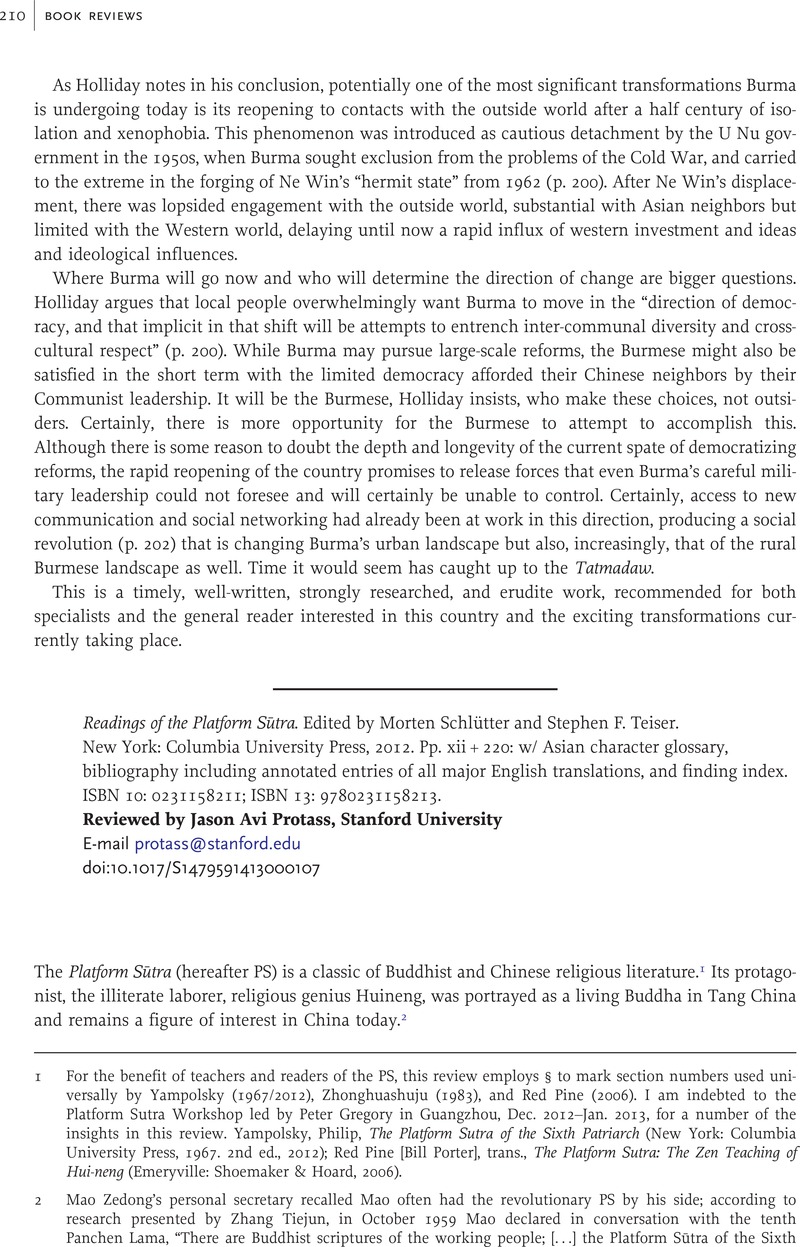No CrossRef data available.
Article contents
Readings of the Platform Sūtra. Edited by Morten Schlütter and Stephen F. Teiser. New York: Columbia University Press, 2012. Pp. xii + 220: w/ Asian character glossary, bibliography including annotated entries of all major English translations, and finding index. ISBN 10: 0231158211; ISBN 13: 9780231158213.
Published online by Cambridge University Press: 20 June 2013
Abstract

- Type
- Book Reviews
- Information
- Copyright
- Copyright © Cambridge University Press 2013
References
1 For the benefit of teachers and readers of the PS, this review employs § to mark section numbers used universally by Yampolsky (1967/2012), Zhonghuashuju (1983), and Red Pine (2006). I am indebted to the Platform Sutra Workshop led by Peter Gregory in Guangzhou, Dec. 2012–Jan. 2013, for a number of the insights in this review. Yampolsky, Philip, The Platform Sutra of the Sixth Patriarch (New York: Columbia University Press, 1967. 2nd ed., 2012)Google Scholar; Pine, Red [Bill Porter], trans., The Platform Sutra: The Zen Teaching of Hui-neng (Emeryville: Shoemaker & Hoard, 2006)Google Scholar.
2 Mao Zedong's personal secretary recalled Mao often had the revolutionary PS by his side; according to research presented by Zhang Tiejun, in October 1959 Mao declared in conversation with the tenth Panchen Lama, “There are Buddhist scriptures of the working people; […] the Platform Sūtra of the Sixth Patriarch is the people's!” Zhang also reports that in an earlier conversation with Tibetan leadership in 1955, Mao likened the Buddhist effort to deliver sentient beings to the Communist effort to liberate the people. I heard this repeated recently by Buddhist-leaning CCP local leaders to promote temple reconstruction. Tiejun, Zhang 张铁军, “Mao Zedong tan Chanzong Liuzu Huineng” 毛泽东谈禅宗六祖慧能 (“Mao Zedong discusses the Chan Sixth Patriarch Huineng”), Literature of Chinese Communist Party 党的文献 6 (2007), pp. 79–80Google Scholar.
3 Yampolsky 2012, p. xii.
4 See especially pp. 204–9. Bielefeldt, Carl, and Lancaster, Lewis, “T'an Ching (Platform Scripture),” Philosophy East and West 25:2 (1975), pp. 197–212CrossRefGoogle Scholar.
5 McRae, John R., trans., The Platform Sutra of the Sixth Patriarch (BDK English Tripitaka. Berkeley: Numata Center for Buddhist Translation and Research, 2000)Google Scholar.
6 Faure, Bernard, “Bodhidharma as Textual and Religious Paradigm,” History of Religions 25:3 (1986), pp. 187–98CrossRefGoogle Scholar.
7 An overview of similar materials closer to Yanagida's point of view is Chapter 2 of Morrison 2010; see Morrison, Elizabeth, The Power of Patriarchs: Qisong and Lineage in Chinese Buddhism (Leiden: Brill, 2010), pp. 51–87CrossRefGoogle Scholar. Sørensen says Northern Chan records of Shenxiu indeed are dualistic (p. 74, n. 35), in disagreement with John McRae 1986, pp. 196–232. See also McRae 2003, pp. 45–53, 85–86. McRae, John R., The Northern School and the Formation of Early Ch'an Buddhism (Honolulu: University of Hawai’i Press, 1986)Google Scholar; McRae, John R., Seeing through Zen: Encounter, Transformation, and Genealogy in Chinese Chan Buddhism (Berkeley: University of California Press, 2003)Google Scholar.
8 The entire article is well worth reading, while pp. 139–48 directly discuss the PS. Bielefeldt, Carl, “Ch'ang-lu Tsung-tse's Tso-ch'an I and the ‘Secret’ of Meditation,” in Traditions of Meditation in Chinese Buddhism, ed. Gregory, Peter, pp. 129–61 (Honolulu: University of Hawai‘i Press, 1986)Google Scholar.
9 See especially pp. 54–58, titled “cultivating Samādhi through constant sitting.” Stevenson, Daniel, “The Four Kinds of Samādhi in Early T'ien-t'ai Buddhism,” in Traditions of Meditation in Chinese Buddhism, ed. Gregory, Peter, pp. 45–97 (Honolulu: University of Hawai‘i Press, 1986)Google Scholar.
10 Faure, Bernard, “The Concept of One-Practice Samādhi in Early Ch'an,” in Traditions of Meditation in Chinese Buddhism, ed. Gregory, Peter, pp. 99–128 (Honolulu: University of Hawai‘i Press, 1986)Google Scholar.
11 Students of the PS may be interested to learn of new perspectives on the term wuxiang 無相, long rendered as “formless” on the grounds that xiang 相 may translate the Sanskrit lakṣaṇa. Considering Paul Harrison's recent exploration of Kumārajīva's use of the same xiang to translate the Sanskrit saṃjñā (“consciousness” or “object of consciousness”), we can also render wuxiangjie 無相戒 as “Precepts with No Mental Objects.” See p. 240 in Harrison, Paul, “Resetting the Diamond: Reflections on Kumārajīva's Chinese Translation of the Vajracchedikā,” Journal of Historical and Philological Studies of China's Western Regions 3 (2010), pp. 233–48Google Scholar.




